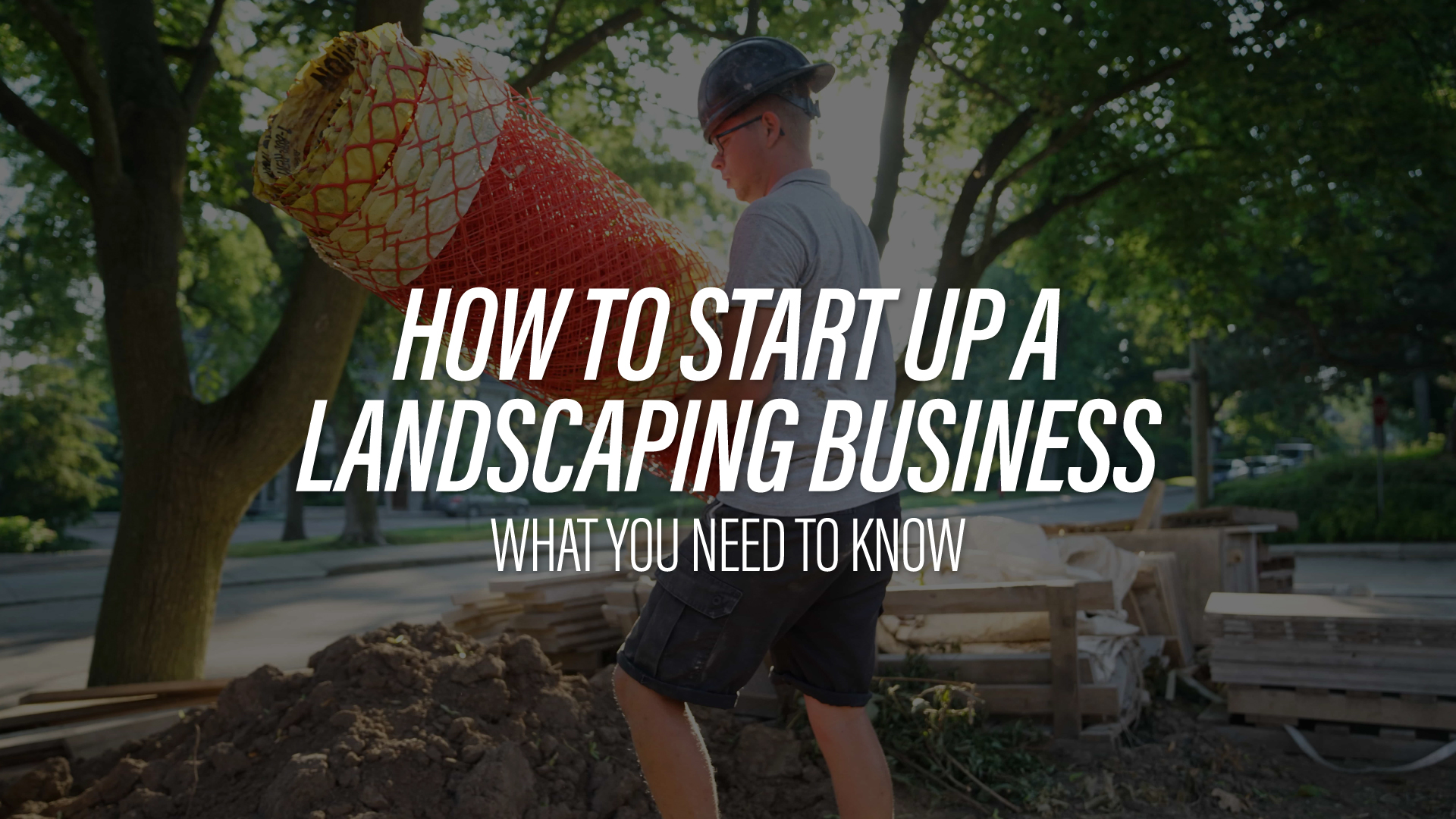Interested in creating your own landscaping business? Congratulations! Starting your own landscaping company can be an incredibly rewarding experience and a lucrative business. Knowing where to start and how to set yourself up for success can be tricky, especially if you have a tight budget, so we’re here to help.
In this guide, we’ll show you how to start a landscaping business with low start-up costs, outlining the foundational information needed to run a business, and which landscaping skills and tools you’ll need to get started. We’ll also provide tips to help you avoid common pitfalls that could sabotage your landscape or lawn care business before it has a chance to succeed.
The Start-Up Period: Defining Your Landscape Business and Your Plan
One of the biggest mistakes landscape businesses make when starting up is biting off more than they can chew. Instead of quitting your job, throwing all your time and efforts into a new business and hoping for the best, carefully consider your approach and what you can afford.
It takes careful planning and steady momentum to grow and scale a business to where it can be a main source of income. Consider starting your lawn care business as a side hustle, rather than a full-time job. It will allow you to generate income after work or on the weekends while you have a steady stream of income to support your personal and business expenses.
The slow and steady approach also goes for your service offerings. Instead of flexing your muscles and stretching yourself too thin, start by determining your target, for instance residential or commercial customers, and choosing one to three landscaping services as your initial focus. While you may have a deep range of landscaping skills, limiting yourself to a handful of offerings (or even just one) will allow you to perfect your craft while you hone your business skills, build a strong reputation and find a rhythm of high quality work. If you’re not sure what to charge, do some research to find out what competitors in your area are charging and it’ll give you a good idea of the going rate.
Remember, starting a business of any kind takes trial and error. Taking advantage of the start- up period to make mistakes and figure out what works better will help you build a stronger, more resilient business that’s better positioned for success.
How Much Does It Cost To Start A Landscape Business?
Ultimately, “how much does it cost to start a landscape business?” is the million-dollar question and while there’s no one answer, start-up costs for landscape businesses vary based on economical timing, budget, scale, and service offerings. There are standard requirements and guidelines to help you determine what it will take to get your business off the ground and help avoid surprises.
Here are some costs to consider for starting up your own landscape or lawn care business:
- Reliable transportation
- Tools, equipment, and supplies
- Maintenance (tools and equipment)
- Storage
- Labor
- Cell phone
- Work computer
- Website
- Logo design
- Business fees, including a bank account
- Government start-up costs (tax identification numbers, permits, etc.)
- Insurance
- Marketing (digital ads, local print ads, etc.)
These costs quickly add up and you’ll often be operating at a loss until you can recoup them. While the full package can be a hefty price, there are ways to reduce the costs of operations. Start by limiting your service offerings, which will ease the financial strain on your business and give your budget more flexibility while you scale up towards additional services and the costs related to them.
Another way to shave costs is to hold off on equipment purchases until you need them.
While tools are essential, you’ll need to make sure you can recoup the costs and have enough cash on hand for other direct business costs to keep your business running.
Traditional landscape businesses should stick to the basics that are easily transportable, versatile, and would cover the basic services needed to take on new work. At minimum, your brand new landscape business should start with reliable transport, a lawn mower, a standard tool kit, and a reliable mobile device to stay in touch with your customers. Instead of buying additional equipment and paying to store it until it’s needed, consider rentals until it becomes a standard need.
How To Budget and Estimate for a Landscaping Business
Knowing how to estimate, job cost and budget are lifelines to keeping your landscape business afloat. Here’s a primer on how to accurately budget, estimate and job cost for your landscaping business:
How To Budget for Beginner Landscapers
Budgets in the first year of running a landscape business are difficult to create because there aren’t any benchmark numbers from previous years. While your first-year budget may seem like educated guesswork, it’s a necessary step to starting a business and an evolving process.
Follow these steps to create your own budget:
- Set your financial goals (revenue and profit)
- Make a plan to meet those goals
- Keep a watchful eye on your budget and adjust accordingly
Once you have some jobs under your belt, it will be easier to make a comprehensive and realistic budget. Landscapers usually build an annual budget by adding up the money they’ve made off jobs the year prior and then tacking on every receipt they’ve received as business costs. That sum shows them what it costs to run the business and what they’re left with for profit.
Click here to read a detailed guide on how to build a landscaping budget.
How To Estimate for Beginner Landscapers
Follow these steps to create your own estimate:
- Specify the services needed by a customer
- Determine the costs of what you need to perform that service, including materials, tool rentals, labor costs, etc.
- Add costs together with your predetermined profit margins and markups
- Submit your estimate to the customer
Coming up with a number in an estimate is relatively easy. Coming up with profitable numbers in an estimate is the hard part. It shouldn’t cost you money to be in business, so make sure you know what profit margin you’d like your business to sit at so you know you’re always making money on a job. For reference, most landscape companies sit at 3% profitability, while experienced businesses can make upwards of 15% above break even rate, and that’s even after all business expenses and taxes.
Click here for an in-depth breakdown on how to create a landscaping estimate.
How To Job Cost For Beginner Landscapers
Job costing is identifying the true costs of a job so that you can accurately estimate future work. At the beginning of starting a landscape or lawn care business, you won’t know how much it costs to complete a job. Using job costing as an exercise can help you identify profitable jobs for your business, where you might be losing money with poor work practices, and speed up your estimating process so you can be the first proposal in your customer’s hands.
Here are some quick tips for job costing:
- Write down job site notes so your numbers have context to your estimates and can see where you went over or under
- Start off with simple data like labor hours and materials costs without the microdetails
- Keep documenting your process so you know if you’re on budget for a job before you get to the finish line without making any adjustments
Click here to read in more detail how to win more profitable landscaping work through job costing.
Keep Your Landscape Business Organized
One of the most surefire ways to cost your business money is weak organization. Keeping your assets organized, including your tools, equipment, customer contacts and back-office data, will save you from wasting time searching for what you need and give you confidence that your business is buttoned up and well cared for.
Here are tips to keep your assets in order:
Landscaping Tools and Equipment Organization
Develop a system to keep your landscaping tools and equipment organized and keep to it. If tools and equipment are always on the move between storage and your truck, designate consistent spots to host your tools and equipment so you know where to find them when you need them.
Toolboxes, bags, or chests also need a system to make sure you aren’t losing utility knives, tape, or other small tools on job sites or even in storage. Checklists are a great system for making sure you aren’t leaving anything behind.
Maintenance and repairs also need to be organized to ensure longevity and careful use of your tools. Create logs for individual pieces of equipment to help you maintain and manage a library without waiting for something to finally break. Preventative steps like this can save you thousands of dollars from avoidable replacement costs that could derail job timelines and yearly budgets.
Customer Info Organization
Customer data needs organization. It’s important to know where to find contact information for each of your customers.
The first steps to organization is to identify the information you need and dedicate a folder for each customer account. Landscaping businesses need a name, phone number, email, and address for each customer. Use the folder to store any other important information and documents that could be useful including previous estimates, invoices, job notes, and photos. While it’s a large undertaking, make sure to keep digital record of every contact.
Vendor Organization
Just like customers, vendors need organization, too. Use the same organizational approach for vendor information as you use to manage customers. Include the data needed to manage invoices and vendor prices for materials to help you better manage budgets when negotiating prices for materials for future jobs. This organizational system should make it easier to manage your taxes at year end too.
Financial Organization
Cash is king in business and managing it requires knowing how it moves. Many landscape businesses struggle with cash moving in and out of their business and can get stuck in uncomfortable positions not knowing when or if they have funds to pay bills. Creating a predictable payments system can help ensure a steady cash flow and avoid the need for dipping into emergency funds.
For peace of mind, create a follow up schedule for customer payments after you send them an invoice. This will help you keep track of money coming into your business. Many businesses forget to follow up with customers or outright forget to send out landscaping invoices, which leads to many services being given away for free.
Learn How To Become A Better Landscape Business Owner
Starting and building your own landscaping business takes a commitment to continually learning and a willingness to experiment, adjust and keep at it.
The more educated you are about the process and intricacies of building a successful land care business, the more likely your business is to be efficient and profitable.
LMN offers educational resources to help build your business. In addition to scores of helpful blog posts and articles, you can find a free Masterclass webinar series, hosted by LMN CEO Mark Bradley, that covers everything from hiring, scaling a business, being a successful leader, and key metrics to measure and monitor for continued growth.
Click here to sign up for the free Masterclass: How To Grow Your Landscaping Business.




